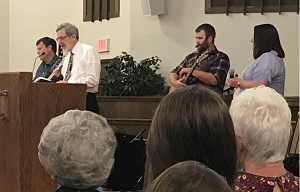Most people see only two divisions of the Bible: the Old Testament, which is viewed primarily for Israel, and the New Testament, which is viewed primarily for the Church. This viewpoint demonstrates a failure to “rightly divide the word of truth” (II Tim. 2:15). Dividing the Scriptures into only two dispensations is insufficient, and dividing between Malachi and Matthew is incorrect.
It’s true that there is a 400 year gap between events of the Old Testament and the events of the New Testament. It’s also true that the Old Testament is written in Hebrew and Aramaic while the New Testament is written in Greek. To understand this issue, we need to look at what the terms “old testament” and “new testament” mean as used in the Scriptures.
The Old Testament
The word “testament” simply means a covenant or an agreement. When God miraculously delivered the nation of Israel out from under Egyptian bondage, He brought them to Mount Sinai. God told them,
“Now therefore, if you will indeed obey My voice and keep My covenant, then you shall be a special treasure to Me above all people; for all the earth is Mine.” (Exo. 19:5)
The covenant He was referring to was the Mosaic Law which He then proceeded to give through His servant, Moses. It is this covenant, the Mosaic law, that is called in Scripture, the “old covenant” or the “old testament” (II Cor. 3:14-15). It is also referred to as the “first” or “former” covenant (Heb. 8:5-7) and it stands in contrast to the “new covenant” or “new testament” (Heb. 8:8-13).
The New Testament
The “new covenant” or “new testament” is prophesied in Jeremiah 31, verses 31-33,
“Behold, the days are coming, says the LORD, when I will make a new covenant with the house of Israel and with the house of Judah—not according to the covenant I made with their fathers in the day that I took them by the hand to lead them out of the land of Egypt, My covenant which they broke, though I was a husband to them, says the LORD. But this is the covenant that I will make with the house of Israel after those days, says the LORD: I will put My law in their minds, and write it on their hearts; and I will be their God, and they shall be My people.”
God promised to make this covenant with “the house of Israel and with the house of Judah,” not with the church, the body of Christ. Both the “old covenant” and the “new covenant” were for Israel, not for the church of this age.
According to the two-fold division of Old and New Testaments, you would assume that the New began with the birth of Jesus, but that is not true. We read in Galatians 4:4-5,
“But when the fullness of the time had come, God sent forth His Son, born of a woman, born under the law, to redeem those who were under the law …”
The birth of Jesus did not signal the end of the covenant of law. He was born “under the law.” We read in Luke 2:27 and 39 that Joseph and Mary did for Jesus “according to the custom of the law” and “performed all things according to the law of the Lord.” They circumcised Him (2:21), presented Him to the Lord (2:22), and offered a sacrifice for Him (2:24).
The real basis for the new testament was not the birth of Jesus, but His death. We read in Hebrews 9:15 that Jesus Christ was
“… the Mediator of the new covenant, by means of death.”
Just because the death of Christ was the basis for the new covenant, this point in time did not necessarily mark the full realization of the new covenant. Jeremiah 31:34 says,
“No more shall every man teach his neighbor, and every man his brother, saying, Know the Lord, for they all shall know Me, from the least of them to the greatest of them, says the LORD …”
This verse describes an aspect of the new covenant which has never been realized; that all Israel “shall know the LORD.” The new covenant still awaits its fulfillment.


